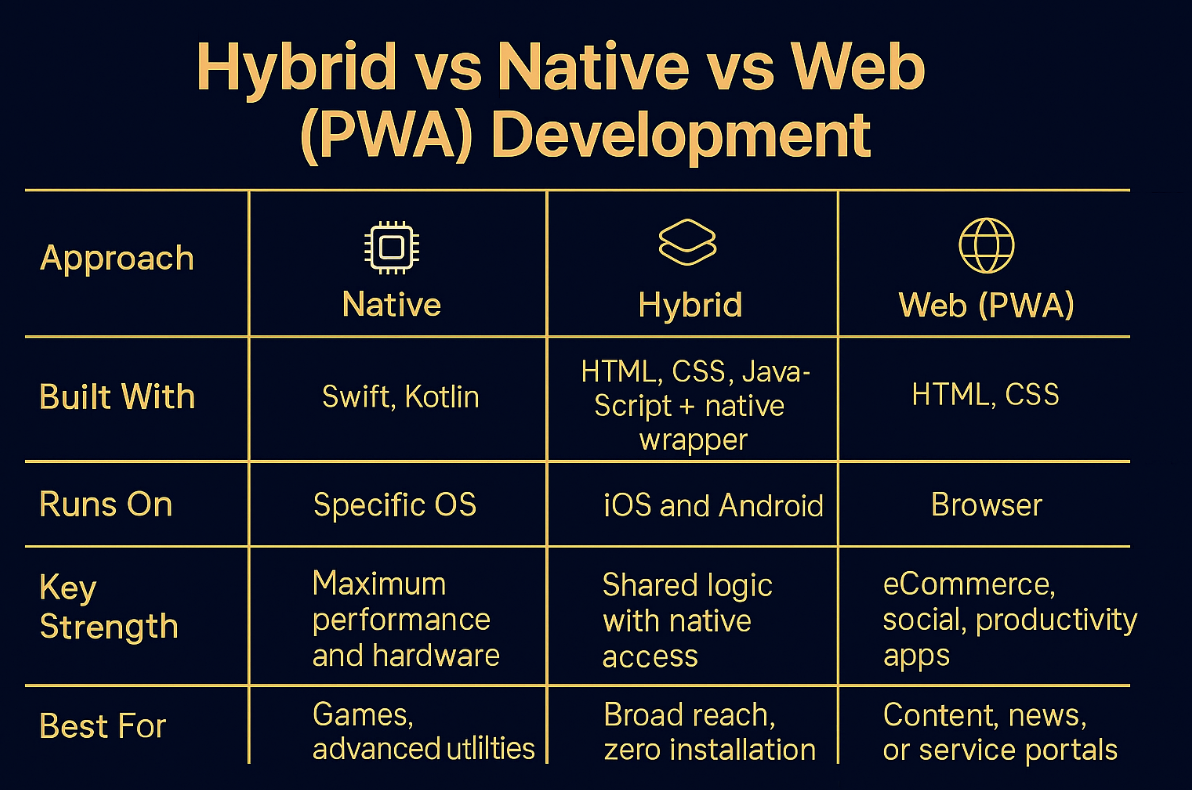Mobile development continues to evolve as businesses look for faster, more efficient ways to reach users across platforms. While native apps remain the benchmark for performance, hybrid frameworks have matured into a reliable alternative that reduces duplication and accelerates delivery.
Industry analyses, including recent insights from Forbes, point out that modern engineering teams increasingly blend native and cross-platform expertise instead of treating them as competing approaches. This shift shows that successful development today depends less on choosing one framework and more on aligning technical choices with long-term product goals.
Hybrid development sits in the center of this spectrum. It allows teams to create a unified codebase while still accessing native device capabilities, making it one of the most practical choices for businesses that value efficiency without sacrificing quality.
What Hybrid Mobile Apps Are
According to TechTarget, a hybrid mobile app combines elements of both native and web applications. Built using standard web technologies such as HTML, CSS, and JavaScript, it runs inside a native shell that enables installation through app stores and access to mobile hardware.
Frameworks like React Native, Flutter, and Ionic provide the tools to connect the web layer with native APIs. The result is a single codebase that operates smoothly across iOS and Android, often with minimal differences in user experience.
From a technical standpoint, the app’s core logic executes within a WebView or compiled layer, while plugins manage device interactions such as camera access, push notifications, or GPS tracking. To users, a well-developed hybrid app behaves like a native one — responsive, consistent, and fully integrated — yet is faster to build and maintain.
How Hybrid Compares to Native and Web Approaches
Every development model serves a different purpose. Native apps are built specifically for one platform, typically in Swift for iOS or Kotlin for Android, and are compiled directly for that system. They offer the best performance, seamless hardware access, and full alignment with OS updates, but they also require maintaining two separate codebases.
Hybrid apps, on the other hand, bridge this gap. They allow developers to write one shared codebase in web technologies, which is then wrapped in a native container for distribution through app stores. This approach simplifies development while maintaining access to most hardware features through plugins or APIs.
Web-based apps, often referred to as Progressive Web Apps (PWAs), extend accessibility even further. They run entirely in the browser, offering instant updates and broad reach, though they lack the deeper integration available to hybrid and native applications.

There is no universal “best” method. The right choice depends on a project’s goals, budget, and technical demands. Many teams now combine these models, using hybrid for broad release, then extending specific features with native modules when deeper system integration is required.
Key Frameworks and Ecosystems
Hybrid app development today revolves around a few mature ecosystems that have shaped how teams build and deploy products across multiple platforms. Each framework offers a slightly different balance between performance, ease of use, and scalability.
- React Native
Originally developed by Meta, React Native remains one of the most established frameworks in the field. It renders native components directly rather than running entirely inside a browser view, which gives it near-native speed and responsiveness. Its large community and plugin library make it a common choice for teams that need both flexibility and a stable ecosystem.
- Flutter
Google’s Flutter compiles to native code and includes its own rendering engine, which ensures consistent visuals across devices. Its widget-based structure allows for precise interface control, making it popular among designers and developers who want a cohesive look on both iOS and Android.
- Ionic with Capacitor
Ionic focuses on the web stack—HTML, CSS, and JavaScript—while Capacitor provides the bridge to native device features. This combination is lightweight and highly approachable for teams with strong web backgrounds, particularly when speed of delivery and modularity are priorities.
- .NET MAUI (formerly Xamarin)
Part of Microsoft’s .NET ecosystem, MAUI supports building cross-platform apps in C#. It compiles to native binaries and integrates naturally with enterprise infrastructure already built on Microsoft technologies.
Together, these frameworks define the current hybrid landscape. They continue to evolve toward tighter integration with native APIs, improved performance, and simpler maintenance, turning hybrid from a cost-driven alternative into a mainstream approach for scalable mobile development.
Advantages of Hybrid App Development
Hybrid development offers practical advantages that make it attractive for many mobile products, especially those aiming for rapid delivery and consistent user experiences across platforms.
- Faster development cycles
A single shared codebase reduces duplication of work. Updates and new features can be released simultaneously for iOS and Android, shortening time-to-market.
- Lower overall cost
Maintaining one codebase typically requires fewer resources than supporting two native teams, making hybrid a cost-effective choice for both startups and established companies.
- Easier maintenance
Fixes and updates are made once and instantly reflected across all supported platforms, simplifying long-term upkeep.
- Consistent user experience
Modern frameworks like Flutter and React Native provide components that adapt smoothly to platform-specific UI patterns, ensuring the app looks and feels familiar on every device.
- Access to native features
Through APIs and plugins, hybrid apps can use hardware capabilities such as cameras, GPS, notifications, and biometric sensors — enough to support most business and consumer use cases.
Hybrid development does not aim to replace native apps entirely; instead, it fills the space where performance, scalability, and development speed need to coexist. This flexibility is what keeps it central to mobile strategy discussions across industries.
Common Limitations of Hybrid Development
Hybrid frameworks have advanced quickly, yet some constraints remain that can affect long-term scalability and performance. Recognizing these early helps teams plan the right balance between efficiency and technical depth.
- Performance variability:
Hybrid apps generally perform well for typical business logic, but heavy tasks — such as real-time rendering, 3D graphics, or AR features — still favor native development. Frameworks like Flutter and React Native reduce this gap, though full parity isn’t always achievable.
- Plugin dependency:
Many hybrid apps depend on external libraries to access device functions like sensors or biometric authentication. When plugins aren’t actively maintained, compatibility issues may appear after OS updates, requiring extra QA cycles or native bridging.
- Interface consistency:
Because hybrid UI components interpret platform design differently, subtle variations in spacing or animation may occur between iOS and Android. Maintaining uniform design often calls for additional styling layers or custom components.
- App size and runtime overhead:
A hybrid app packages a web runtime along with its logic, which can slightly increase file size compared to a native equivalent. While this rarely affects user experience, it can matter for regions with bandwidth limits or strict store size thresholds.
These aren’t disqualifying factors — they simply define where hybrid fits best. The approach works exceptionally well for applications that prioritize shared logic and rapid release cycles, provided the team accounts for these nuances during planning and testing.
When Hybrid Is and Isn’t the Right Choice
Choosing between hybrid, native, and web development depends on the type of product being built and the goals behind it. Each approach has its place, and hybrid development works best when reach, efficiency, and consistency matter more than platform-specific depth.
Hybrid works well when:
- The goal is to launch simultaneously on iOS and Android without maintaining two separate codebases.
- The app focuses on content, user interaction, or transactional workflows rather than complex hardware functions.
- The team already has experience with web technologies such as JavaScript, HTML, and CSS.
- Time-to-market is critical, such as in MVPs, pilot launches, or frequent iteration cycles.
- Maintenance efficiency and faster release cadence are higher priorities than maximum native optimization.
Hybrid may not be ideal when:
- The app demands heavy 3D graphics, AR, or other performance-critical features that depend on low-level APIs.
- The product relies on specialized hardware integrations or system-level services.
- Platform-specific design precision or the latest OS features are central to user experience.
For many organizations, hybrid development serves as a strategic bridge, allowing a single team to maintain multi-platform consistency while evaluating which features might later require native extensions. Understanding these boundaries early makes it easier to plan a development strategy that grows with the product, rather than against it.
Conclusion
Hybrid mobile app development has become a dependable middle ground in a landscape once defined by strict divisions between native and web approaches. It offers the flexibility to reach both major mobile ecosystems with a unified codebase, while still maintaining access to most native capabilities. For many businesses, this balance translates into shorter release cycles, simplified updates, and a faster route from concept to market.
Yet the best choice always depends on context. Projects that demand heavy computation, immersive visuals, or advanced system integrations still benefit from native development, while others may find that a hybrid or even web-first approach offers greater agility. Understanding how these options align with business goals, technical resources, and long-term scalability is the foundation of an effective mobile strategy.
LenGreo helps companies evaluate these trade-offs and define the right path for their digital products, whether that means building a fully native solution, developing a hybrid app for cross-platform reach, or creating a progressive web experience that evolves alongside user expectations.









